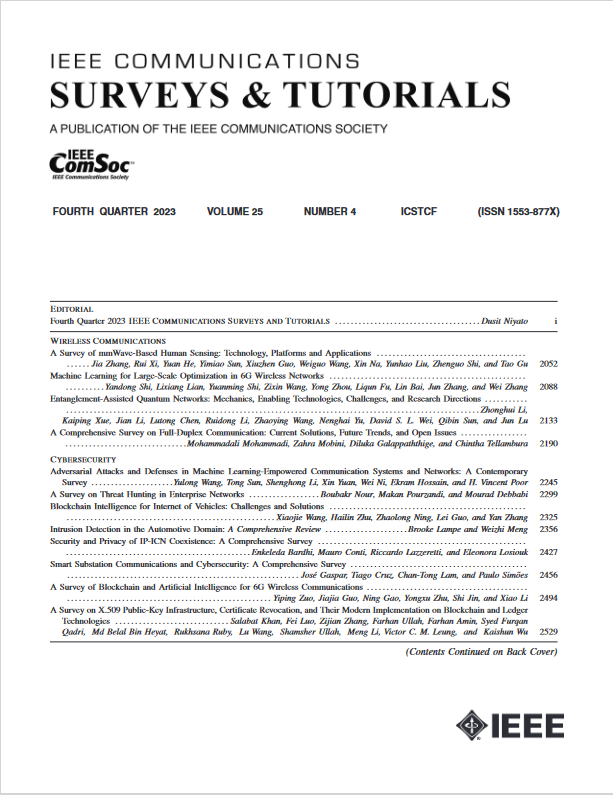From Simulators to Digital Twins for Enabling Emerging Cellular Networks: A Tutorial and Survey
IF 34.4
1区 计算机科学
Q1 COMPUTER SCIENCE, INFORMATION SYSTEMS
引用次数: 0
Abstract
Simulators are indispensable parts of the research and development necessary to advance countless industries, including cellular networks. With simulators, the evaluation, analysis, testing, and experimentation of novel designs and algorithms can be executed in a more cost-effective and convenient manner without the risk of real network service disruption. Additionally, recent trends indicate that the advancement of these Digital System Models (DSM), such as system-level simulators, will hold a pivotal role in advancing cellular networks by facilitating the development of digital twins. Given this growing significance, in this survey and tutorial paper, we present an extensive review of the currently available DSMs for 5G and beyond (5G&B) networks. Specifically, we begin with a tutorial on the fundamental concepts of 5G&B network simulations, followed by an identification of the essential design requirements needed to model the key features of these networks. We also devised a taxonomy of different types of 5G&B network simulators. In contrast to existing simulator surveys, which mostly leverage traditional metrics applicable to legacy networks, we devise and use 5G-specific evaluation metrics that capture three key facets of a network simulator, namely realism, completeness, and computational efficiency. We evaluate each simulator according to the devised metrics to generate an applicability matrix that maps different 5G&B simulators vis-à-vis the different research themes they can potentially enable. We also present the current challenges in developing 5G&B simulators while laying out several potential solutions to address the issues. Finally, we discuss the future challenges related to simulator design provisions that will arise with the emergence of 6G networks.从模拟器到数字双胞胎,助力新兴蜂窝网络:教程与调查
模拟器是推动包括蜂窝网络在内的无数行业发展所必需的研究和开发不可或缺的一部分。有了模拟器,新设计和算法的评估、分析、测试和实验可以以更经济、更方便的方式执行,而不会有真正的网络服务中断的风险。此外,最近的趋势表明,这些数字系统模型(DSM)的进步,如系统级模拟器,将通过促进数字孪生的发展,在推进蜂窝网络方面发挥关键作用。鉴于这一日益重要的意义,在本调查和教程中,我们对目前可用的5G及以上(5G& b)网络的dsm进行了广泛的回顾。具体来说,我们从5g和b网络模拟的基本概念的教程开始,然后确定建模这些网络的关键特征所需的基本设计要求。我们还设计了不同类型的5G&B网络模拟器的分类。现有的模拟器调查主要利用适用于遗留网络的传统指标,与之相反,我们设计并使用了5g特定的评估指标,这些指标捕捉了网络模拟器的三个关键方面,即真实感、完整性和计算效率。我们根据设计的指标评估每个模拟器,以生成一个适用性矩阵,该矩阵将不同的5g和b模拟器映射到-à-vis它们可能实现的不同研究主题。我们还提出了开发5G&B模拟器的当前挑战,同时提出了解决这些问题的几种潜在解决方案。最后,我们讨论了随着6G网络的出现而出现的与模拟器设计条款相关的未来挑战。
本文章由计算机程序翻译,如有差异,请以英文原文为准。
求助全文
约1分钟内获得全文
求助全文
来源期刊

IEEE Communications Surveys and Tutorials
COMPUTER SCIENCE, INFORMATION SYSTEMS-TELECOMMUNICATIONS
CiteScore
80.20
自引率
2.50%
发文量
84
审稿时长
6 months
期刊介绍:
IEEE Communications Surveys & Tutorials is an online journal published by the IEEE Communications Society for tutorials and surveys covering all aspects of the communications field. Telecommunications technology is progressing at a rapid pace, and the IEEE Communications Society is committed to providing researchers and other professionals the information and tools to stay abreast. IEEE Communications Surveys and Tutorials focuses on integrating and adding understanding to the existing literature on communications, putting results in context. Whether searching for in-depth information about a familiar area or an introduction into a new area, IEEE Communications Surveys & Tutorials aims to be the premier source of peer-reviewed, comprehensive tutorials and surveys, and pointers to further sources. IEEE Communications Surveys & Tutorials publishes only articles exclusively written for IEEE Communications Surveys & Tutorials and go through a rigorous review process before their publication in the quarterly issues.
A tutorial article in the IEEE Communications Surveys & Tutorials should be designed to help the reader to become familiar with and learn something specific about a chosen topic. In contrast, the term survey, as applied here, is defined to mean a survey of the literature. A survey article in IEEE Communications Surveys & Tutorials should provide a comprehensive review of developments in a selected area, covering its development from its inception to its current state and beyond, and illustrating its development through liberal citations from the literature. Both tutorials and surveys should be tutorial in nature and should be written in a style comprehensible to readers outside the specialty of the article.
 求助内容:
求助内容: 应助结果提醒方式:
应助结果提醒方式:


